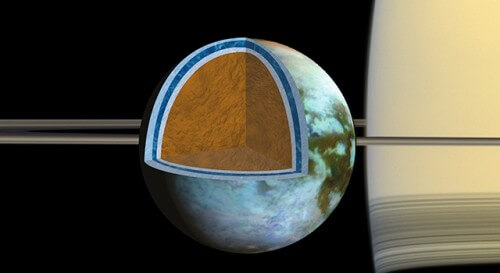Scientists examining findings from NASA's Cassini spacecraft have discovered strong evidence that the subsurface ocean on Saturn's large moon Titan may be as salty as the Dead Sea.

Scientists examining findings from NASA's Cassini spacecraft have discovered strong evidence that the subsurface ocean on Saturn's large moon Titan may be as salty as the Dead Sea.
The new findings come from a study of gravity and topography data collected during Cassini's many flybys of Titan over the past decade. The scientists who used the Cassini data presented a structural model for Titan that provides improved insight into the structure of the moon's outer icy crust.
The findings were published this week in the journal Ikaros.
"Titan continues to prove that it is a fascinating world, and with the help of the Cassini spacecraft, which is extending over the years, new mysteries can be solved at the same rate as old ones are solved," says Linda Spilker, Cassini's chief scientist at NASA's Jet Propulsion Laboratory in Pasadena, California, who was not involved in the research.
Additional findings support the previous estimates that the ice shell covering Titan is hard (hardening) and in the process (and is in the process) of turning into solid ice.
The researchers discovered that to explain the gravity data, a great density of the underground ocean is required. This indicates that the ocean consists of water that also contains salts consisting of sulfur, sodium and potassium. The density indicates a salt content more or less similar to that found in the most saline bodies of water on Earth.
"This is a very salty ocean on the scale of the Earth," says the lead author of the article, Giuseppe Mitri from the University of Nantes in France. "This knowledge may change our perspective on the ocean as a place where life can exist today, but conditions in the past may have been different."
Cassini data indicate that the thickness of the ice layer varies slightly from place to place. The researchers say this is due to Titan's slow capping and resulting gradual freezing of the ocean, otherwise, the moon's shape would have become smooth over time like hot candle wax. This freezing process has heavy consequences for the ocean's ability to sustain life, as it limits the exchange of substances between the surface and the ocean.
Another implication of the hardening of the ice crust, according to the study, is that any leakage of methane into Titan's atmosphere must occur in scattered "hot zones" such as the hot spots on Earth that caused the rise of the Hawaiian island chain. The methane on Titan was not emitted as a result of plate motion recycling the ice in the lunar crust.
The question of how methane reached Titan's atmosphere has been a puzzle for researchers for a long time because molecules of this gas break down in sunlight during short geological periods. Titan's atmosphere contains about 5% methane. This means that some process, which is likely to be geological in nature, must renew the concentration of the gas. The study indicates that regardless of the nature of the process, the return to the atmosphere of methane on Titan is local and temporary.
"It will be very difficult to locate the renewal sources of methane in the equipment that will be on Cassini and future missions will be required that can find local methane reservoirs" says Jonathan Lunin, Cassini mission scientist from Cornell University and one of the authors of the paper. "Like on Mars, it's always a challenging task."

3 תגובות
And what about the moon Europa?